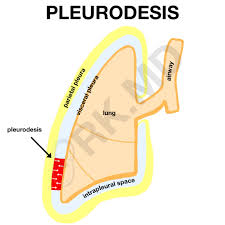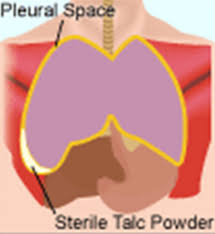
 A medical procedure in which the pleural space is artificially obliterated.
A medical procedure in which the pleural space is artificially obliterated.
It involves the adhesion of the two pleurae.
It is performed to prevent recurrence of pneumothorax or recurrent pleural effusion.
It can be done chemically or surgically.
Bleomycin, tetracycline, povidone-iodine, or a slurry of talc can be introduced into the pleural space through a chest tube.
The chemicals place in the pleural,space cause irritation between the parietal and the visceral layers of the pleura which closes off the space between them and prevents further fluid from accumulating.
Povidone iodine is equally effective and safe as talc, and may be pref2242ed because of easy availability and low cost.
Chemical pleurodesis is painful and patients are often premedicated with a sedative and analgesics.
Local anesthetic may be instilled into the pleural space,and or an epidural catheter may be placed for anesthesia.
Surgical pleurodesis can be,performed via thoracotomy or thoracoscopy: mechanically irritating the parietal pleura.
Pleural catheters may be placed with portable vacuum bottles to evacuate the pleural fluid keeping the pleura together, resulting in physical agitation by the catheter, causing the pleura to scar together.
This measure takes an average of about 30 days to achieve and is therefore the slowest means of achieving pleurodesis.
Presently talc is the pref2242ed treatment for pleurodesis by the majority of chest physicians.
With talc can lead to acute respiratory distress syndrome.
Remains the default treatment for the majority of patients with malignant pleural effusion.
Talc is delivered through the intercostal chest tube in the form of slurry or spray directly onto the pleural surface during a thoroscopic procedure.
No significant differences exist in the pleurodesis failure rate between talc poudrage and talc slurry.
